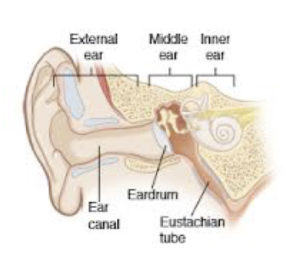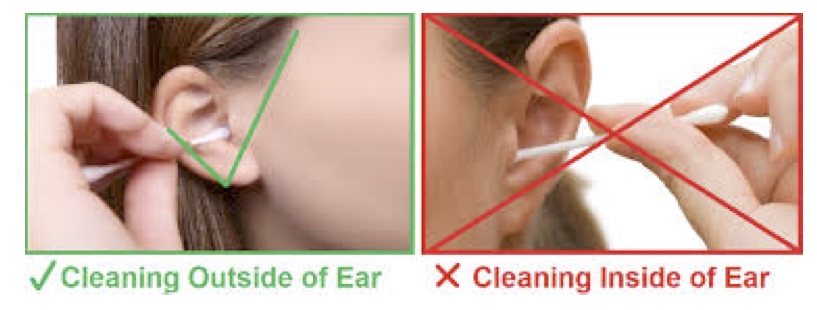Doctors’ Notes
BackRemoving Earwax
An important part of a patient visit to our office involves the Medical Provider seeing the inside components of the ear.

As you can see from the diagram that there are three parts of the ear, but only two parts of the ear — Outer (External) and Middle — can be grossly seen by instrumentation from outside the ear.
The separation of the external ear and the middle ear is the eardrum. An otoscope with an appropriate ear speculum and bright light is inserted into the ear canal to see the eardrum and the space behind it. But sometimes earwax is in the way, and it blocks the view in the ear canal.
You can learn more about earwax from my Doctor’s Note on Earwax.
Earwax Impaction
 Earwax can fall out or be removed by washing. It can also build up and block the ear canal. This is called cerumen (earwax) impaction. Common symptoms can develop, including earache, tinnitus (ringing in the ears), partial hearing loss due to conductive sound dysfunction, and a sensation of fullness in the ear (“plugged”). Causes of earwax impaction can include hereditary (familial cause), use of hearing aids, insertion of Q-tips, or use of ear buds.
Earwax can fall out or be removed by washing. It can also build up and block the ear canal. This is called cerumen (earwax) impaction. Common symptoms can develop, including earache, tinnitus (ringing in the ears), partial hearing loss due to conductive sound dysfunction, and a sensation of fullness in the ear (“plugged”). Causes of earwax impaction can include hereditary (familial cause), use of hearing aids, insertion of Q-tips, or use of ear buds.
Earwax Removal
Removal of earwax is essential at times if it is causing these symptoms, or if it’s blocking the view of the clinician to see the eardrum (tympanic membrane).
Earwax removal can be treated at home. First step may be to soften the earwax. Some common remedies to soften the earwax include:
1. Commercial drops (for example: Debrox)
2. Mineral oil
3. Glycerin
4. Olive oil
5. Water
The next step is to flush out the ear using water. There are kits sold over-the-counter (OTC) to gently help with flushing the ear. If you use them, it’s important to follow the directions carefully, for too strong a technique could rupture the eardrum. (See below for details on this method and precautions to take.)
• Use body-temperature water (cooler or warmer water may cause dizziness or vertigo).
• Hold the head upright and straighten the ear canal by holding the outside ear cartilage and gently pulling upward
• Use a syringe (you can buy one at the store) to gently direct a small steady stream of water against the ear canal wall next to the wax plug
• Tip the head to allow the water to drain. You may need to repeat irrigation several times.
• Dry the ear canal by applying a few drops of rubbing alcohol or Swimmer’s eardrops (OTC).
To Avoid Damaging Your Ear or Causing an Infection
- Never irrigate the ear if the eardrum may have a hole in it (for kids with ear tubes)
- Do not irrigate the ear with a jet irrigator designed for cleaning teeth (such as a WaterPik)
- Do not use Q-tips or anything smaller than your elbow in your ear canal

Removing Earwax in the Office
Sometimes, a Medical Provider may need to remove the earwax in our office. In fact, according to one study, earwax needs to be removed to visualize the eardrum in up to 29% of doctor’s visits!
Reasons for this necessary procedure include if the family member cannot remove the wax build-up, or if the patient has ear discomfort, a fever, ear drainage, or hearing loss. An accurate diagnosis depends on our ability to see clearly from the outer ear to the eardrum and beyond (the Middle Ear space).
The Provider may remove the wax from each ear by:
• Repeating the irrigation attempts
• Suctioning the ear canal
• Using a small loop device called a curette to carefully scoop out the earwax
Whatever method the Provider chooses, he or she will clearly explain what will be done and review the risks and benefits of the cerumen removal procedure. Each ear is considered separately and warrants its own procedure.
This procedure becomes part of the office visit, and, in most cases, is a covered procedure service under most insurance plans. The Provider documents the reason(s) for the procedure to assist in understanding the procedure requirement.
A child’s ears can be a source of many concerns and symptoms, and it is very important that they are evaluated carefully and completely uninhibited by earwax. Remember: safety first, because of how small and precious your child’s ears are!
Dr. Lucas Godinez, a Shareholder in the practice, has been a Kids Plus Provider since 2004. He teaches a monthly Expectant Parent Orientation class at our Squirrel Hill/Greenfield office.